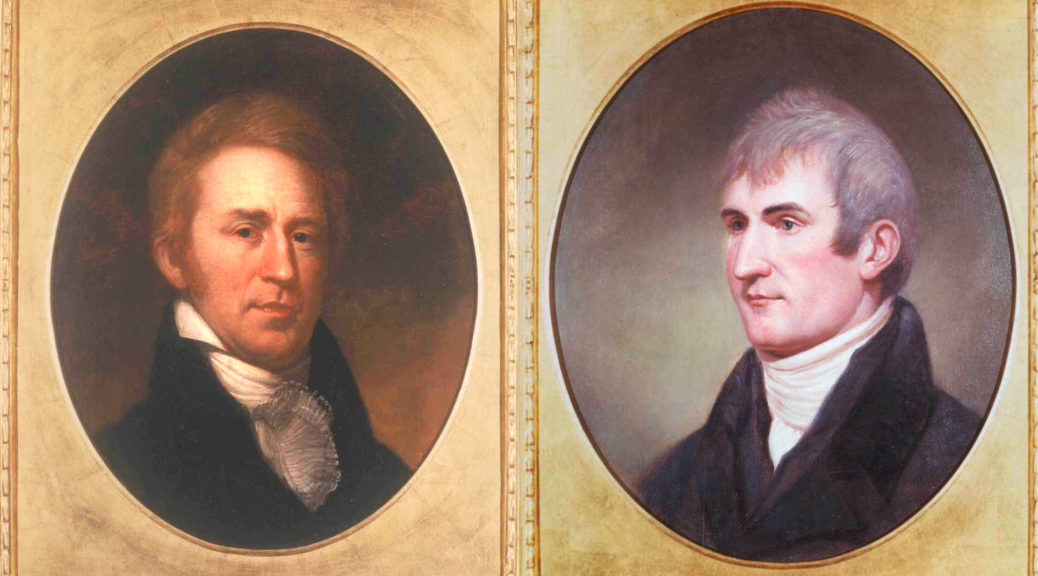On this date MERIWEATHER LEWIS and WILLIAM CLARK returned to Missouri after their two year journey to explore the Louisiana Purchase under commission from President Thomas Jefferson.
The LEWIS AND CLARK EXPEDITION, also known as the Corps of Discovery Expedition, was the first American expedition to cross what is now the western portion of the United States, departing in May, 1804 from St. Louis on the Mississippi River, making their way westward through the continental divide to the Pacific coast.
The expedition was commissioned by President Jefferson shortly after the Louisiana Purchase in 1803, consisting of a select group of U.S. Army volunteers under the command of Captain Meriwether Lewis and his close friend Second Lieutenant William Clark. The duration of their perilous journey lasted from May 1804 to September 1806. The primary objective was to explore and map the newly acquired territory, find a practical route across the Western half of the continent, and establish an American presence in this territory before Britain and other European powers tried to claim it.
The campaign’s secondary objectives were scientific and economic: to study the area’s plants, animal life, and geography, and establish trade with local Indian tribes. With maps, sketches and journals in hand, the expedition returned to St. Louis to report their findings to Jefferson.
Sacagawea, sometimes called Sakajawea or Sakagawea (c. 1788–December 20, 1812), was a Shoshone Indian woman who arrived with her husband Toussant Charbonneau on the expedition to the Pacific Ocean. Though a crucial addition to the expedition and though she has been discussed in literature frequently, much of the information is exaggeration or fiction. Scholars say she did notice some geographical features, but “Sacagawea…was not the guide for the Expedition, she was important to them as an interpreter and in other ways.” The sight of a woman and her infant son would have been reassuring to some indigenous nations, and she played an important role in diplomatic relations by talking to chiefs, easing tensions, and giving the impression of a peaceful mission.
On Feb. 11, 1805, a few weeks after her first contact with the expedition, Sacagawea went into labor and gave birth to a baby boy. Her labor was slow and painful and so the Frenchman Charbonneau, with whom she had arrived on the scene, suggested that she be given a potion of rattlesnake’s rattle to aid in her delivery. Lewis happened to have some snakes rattle with him. A short time after administering the potion she delivered a healthy baby boy who was given the name JEAN BAPTISTE CHARBONNEAU.
He was later informally adopted by Clark. In his fascinating and highly recommended history of the same-sex activities among the early Western trappers , Men In Eden: William Drummond Stewart and Same-Sex Desire in the Rocky Mountain Fur Trade, William Benemann reveals that Charbonneau may well have gone on to become a very well-kept young man:
“In 1823, when the 25 year old Duke Paul Wilhelm of Wurtemberg first visited St. Louis, he was drawn to the young man. ‘Here I found a youth of sixteen,’ the Duke later wrote, ‘whose mother was of the tribe of Sho-sho-ne, or Snake Indians, and who had accompanied Mssrs. Lewis and Clark to the Pacific Ocean in the years 1804 to 1806 [as] interpretress. This Indian woman was married to the French interpreter of the expedition, Toussaint Charbonneau by name. Charbonneau rendered me service also, some time later in the same capacity, and Baptiste, his son (the youth of sixteen) of whom I made mention above, joined me on my return and followed me to Europe and has remained with me ever since.”
Baptiste was 18, not 16 at the time but appeared younger. Sacagawea had died from a fever, and both Charbonneau and Clark realized that this was a tremendous opportunity for the young man. The Duke was offering to take the youth under his wing, and with their blessing Baptiste sailed for Europe with his new patron, eventually settling in the Duke’s 11th century castle on the outskirts of Stuttgart. They traveled extensively and over the years the Duke brought back several foreign boys from his various travels. And though Jean Baptiste went on to marry and father a child, he never acknowledged the woman or her child and he remained a lifelong bachelor.
